CSE1L, as a novel prognostic marker, promotes pancreatic cancer proliferation by regulating the AKT/mTOR signaling pathway
- PMID: 33854580
- PMCID: PMC8040880
- DOI: 10.7150/jca.54482
CSE1L, as a novel prognostic marker, promotes pancreatic cancer proliferation by regulating the AKT/mTOR signaling pathway
Abstract
Pancreatic cancer is one of the most aggressive tumors with poor prognosis and new targetable therapies are urgently required. CSE1L (chromosome segregation 1 like) is thought to play an important role in tumorigenesis and acts as a cancer therapeutic target. However, the biological function and the underlying mechanism of CSE1L in pancreatic cancer are still not fully explicit. In the present study, we found that high CSE1L expression was related to a worse prognosis in patients with pancreatic cancer according to data from the Cancer Genome Atlas (TCGA) database. Additionally, we found that CSE1L knockdown inhibited the proliferation of pancreatic cancer cells and promoted apoptosis, while CSE1L overexpression demonstrated the opposite phenomenon. Furthermore, we discovered that CSE1L might regulate pancreatic cancer proliferation through AKT signaling pathway. In summary, we reveal that CSE1L plays a crucial role in tumor growth and may serve as a potential prognostic and therapeutic target for pancreatic cancer.
Keywords: AKT/mTOR signaling pathway.; CSE1L; pancreatic cancer; proliferation.
© The author(s).
Conflict of interest statement
Competing Interests: The authors have declared that no competing interest exists.
Figures
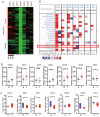

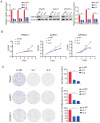
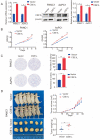
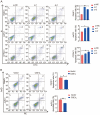
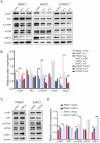
Similar articles
-
CSE1L promotes proliferation and migration in oral cancer through positively regulating MITF.Eur Rev Med Pharmacol Sci. 2020 May;24(10):5429-5435. doi: 10.26355/eurrev_202005_21327. Eur Rev Med Pharmacol Sci. 2020. PMID: 32495878
-
CSE1L silence inhibits the growth and metastasis in gastric cancer by repressing GPNMB via positively regulating transcription factor MITF.J Cell Physiol. 2020 Mar;235(3):2071-2079. doi: 10.1002/jcp.29107. Epub 2019 Jul 25. J Cell Physiol. 2020. PMID: 31347172
-
Nuclear export protein CSE1L interacts with P65 and promotes NSCLC growth via NF-κB/MAPK pathway.Mol Ther Oncolytics. 2021 Mar 10;21:23-36. doi: 10.1016/j.omto.2021.02.015. eCollection 2021 Jun 25. Mol Ther Oncolytics. 2021. PMID: 33869740 Free PMC article.
-
Cellular apoptosis susceptibility (CSE1L/CAS) protein in cancer metastasis and chemotherapeutic drug-induced apoptosis.J Exp Clin Cancer Res. 2010 Aug 11;29(1):110. doi: 10.1186/1756-9966-29-110. J Exp Clin Cancer Res. 2010. PMID: 20701792 Free PMC article. Review.
-
CAS (CSE1L) signaling pathway in tumor progression and its potential as a biomarker and target for targeted therapy.Tumour Biol. 2016 Oct;37(10):13077-13090. doi: 10.1007/s13277-016-5301-x. Epub 2016 Sep 5. Tumour Biol. 2016. PMID: 27596143 Review.
Cited by
-
Exosomal miRNA 16-5p/29a-3p from pancreatic cancer induce adipose atrophy by inhibiting adipogenesis and promoting lipolysis.iScience. 2024 Jun 21;27(7):110346. doi: 10.1016/j.isci.2024.110346. eCollection 2024 Jul 19. iScience. 2024. PMID: 39055920 Free PMC article.
-
Integrated transcriptome analysis of CSE1L regarding poor prognosis and immune infiltration in bladder urothelial carcinoma and experimental verification.Front Immunol. 2024 Oct 4;15:1449251. doi: 10.3389/fimmu.2024.1449251. eCollection 2024. Front Immunol. 2024. PMID: 39430746 Free PMC article.
-
Impact of pan-cancer analysis of the exportins family on prognosis, the tumor microenvironment and its potential therapeutic efficacy.Clin Exp Med. 2024 Dec 21;25(1):18. doi: 10.1007/s10238-024-01534-6. Clin Exp Med. 2024. PMID: 39708137 Free PMC article.
-
Analysis of the Anticancer Mechanism of OR3 Pigment from Streptomyces coelicolor JUACT03 Against the Human Hepatoma Cell Line Using a Proteomic Approach.Cell Biochem Biophys. 2024 Jun;82(2):1061-1077. doi: 10.1007/s12013-024-01258-0. Epub 2024 Apr 5. Cell Biochem Biophys. 2024. PMID: 38578403
-
Nuclear transport proteins: structure, function, and disease relevance.Signal Transduct Target Ther. 2023 Nov 10;8(1):425. doi: 10.1038/s41392-023-01649-4. Signal Transduct Target Ther. 2023. PMID: 37945593 Free PMC article. Review.
References
-
- Bray F, Ferlay J, Soerjomataram I, Siegel RL, Torre LA, Jemal A. Global cancer statistics 2018: GLOBOCAN estimates of incidence and mortality worldwide for 36 cancers in 185 countries. CA Cancer J Clin. 2018;68:394–424. - PubMed
-
- Rahib L, Smith BD, Aizenberg R, Rosenzweig AB, Fleshman JM, Matrisian LM. Projecting cancer incidence and deaths to 2030: the unexpected burden of thyroid, liver, and pancreas cancers in the United States. Cancer Res. 2014;74:2913–21. - PubMed
-
- Siegel RL, Miller KD, Jemal A. Cancer statistics, 2020. CA Cancer J Clin. 2020;70:7–30. - PubMed
LinkOut - more resources
Full Text Sources
Other Literature Sources
Miscellaneous

